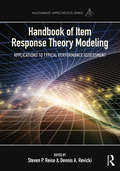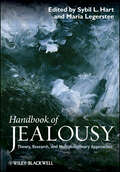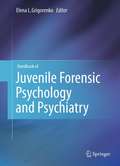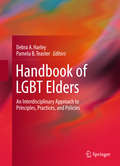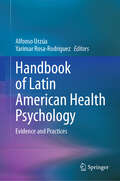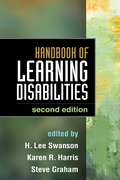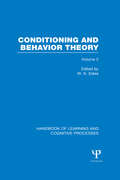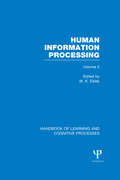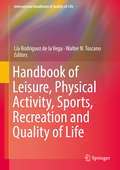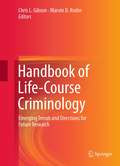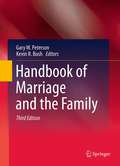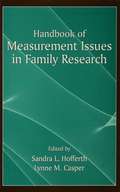- Table View
- List View
Handbook of Issues in Criminal Justice Reform in the United States
by Cynthia Calkins Elizabeth JeglicThis handbook provides a holistic and comprehensive examination of issues related to criminal justice reform in the United States from a multidisciplinary perspective. Divided into five key domains of reform in the criminal justice system, it analyzes: - Policing- Policy and sentencing- Reentry- Treatment- Alternatives to incarcerationEach section provides a history and overview of the domain within the criminal justice system, followed by chapters discussing issues integral to reform. The volume emphasizes decreasing incarceration and minimizing racial, ethnic and economic inequalities. Each section ends with tangible recommendations, based on evidence-based approaches for reform. Of interest to researchers, scholars, activists and policy makers, this unique volume offers a pathway for the future of criminal justice reform in the United States.
Handbook of Item Response Theory Modeling: Applications to Typical Performance Assessment (Multivariate Applications Series)
by Steven P. Reise and Dennis A. RevickiItem response theory (IRT) has moved beyond the confines of educational measurement into assessment domains such as personality, psychopathology, and patient-reported outcomes. Classic and emerging IRT methods and applications that are revolutionizing psychological measurement, particularly for health assessments used to demonstrate treatment effectiveness, are reviewed in this new volume. World renowned contributors present the latest research and methodologies about these models along with their applications and related challenges. Examples using real data, some from NIH-PROMIS, show how to apply these models in actual research situations. Chapters review fundamental issues of IRT, modern estimation methods, testing assumptions, evaluating fit, item banking, scoring in multidimensional models, and advanced IRT methods. New multidimensional models are provided along with suggestions for deciding among the family of IRT models available. Each chapter provides an introduction, describes state-of-the art research methods, demonstrates an application, and provides a summary. The book addresses the most critical IRT conceptual and statistical issues confronting researchers and advanced students in psychology, education, and medicine today. Although the chapters highlight health outcomes data the issues addressed are relevant to any content domain. The book addresses: IRT models applied to non-educational data especially patient reported outcomes Differences between cognitive and non-cognitive constructs and the challenges these bring to modeling. The application of multidimensional IRT models designed to capture typical performance data. Cutting-edge methods for deriving a single latent dimension from multidimensional data A new model designed for the measurement of constructs that are defined on one end of a continuum such as substance abuse Scoring individuals under different multidimensional IRT models and item banking for patient-reported health outcomes How to evaluate measurement invariance, diagnose problems with response categories, and assess growth and change. Part 1 reviews fundamental topics such as assumption testing, parameter estimation, and the assessment of model and person fit. New, emerging, and classic IRT models including modeling multidimensional data and the use of new IRT models in typical performance measurement contexts are examined in Part 2. Part 3 reviews the major applications of IRT models such as scoring, item banking for patient-reported health outcomes, evaluating measurement invariance, linking scales to a common metric, and measuring growth and change. The book concludes with a look at future IRT applications in health outcomes measurement. The book summarizes the latest advances and critiques foundational topics such a multidimensionality, assessment of fit, handling non-normality, as well as applied topics such as differential item functioning and multidimensional linking. Intended for researchers, advanced students, and practitioners in psychology, education, and medicine interested in applying IRT methods, this book also serves as a text in advanced graduate courses on IRT or measurement. Familiarity with factor analysis, latent variables, IRT, and basic measurement theory is assumed.
Handbook of Jealousy
by Maria Legerstee Sybil L. HartThrough a compilation of original articles, the Handbook of Jealousy offers an integrated portrait of the emerging areas of research into the nature of jealousy and a forum for discussing the implications of the findings for theories of emotional and socio-cognitive development.Presents the most recent findings and theories on jealousy across a range of contexts and age-stages of developmentIncludes 23 original articles with empirical findings and detailed commentaries by leading experts in the fieldServes as a valuable resource for professionals in the fields of clinical psychology, psychiatry, and social work, as well as scholars in the fields of psychology, family studies, sociology, and anthropology
Handbook of Juvenile Forensic Psychology and Psychiatry
by Elena L. GrigorenkoJuvenile justice centers have a long tradition as an unfortunate stop for young offenders who need mental health care. Reports estimate that as many as 70% of the youth in detention centers meet criteria for mental health disorders. As juvenile justice systems once again turn their focus from confinement to rehabilitation, mental health providers have major opportunities to inform and improve both practice and policy. The Handbook of Juvenile Forensic Psychology and Psychiatry explores these opportunities by emphasizing a developmental perspective, multifaceted assessment, and evidence-based practice in working with juvenile offenders. This comprehensive volume provides insights at virtually every intersection of mental health practice and juvenile justice, covering areas as wide-ranging as special populations, sentencing issues, educational and pharmacological interventions, family involvement, ethical issues, staff training concerns, and emerging challenges. Together, its chapters contain guidelines not only for changing the culture of detention but also preventing detention facilities from being the venue of choice in placing troubled youth. Key issues addressed in the Handbook include: Developmental risks for delinquency.Race and sex disparities in juvenile justice processing.Establishing standards of practice in juvenile forensic mental health assessment.Serving dually diagnosed youth in the juvenile justice system.PTSD among court-involved youth.Female juvenile offenders.Juvenile sex offenders.The Handbook of Juvenile Forensic Psychology and Psychiatry is an essential reference for researchers, professors, allied clinicians and professionals, and policy makers across multiple fields, including child and school psychology, child and adolescent psychiatry, developmental psychology, criminology, juvenile justice, forensic psychology, neuropsychology, social work, and education.
Handbook of LGBT Elders
by Debra A. Harley Pamela B. TeasterThis groundbreaking resource presents a wealth of findings and perspectives previously unseen in the LGBT literature. Its focus on psychological, sociopolitical and care delivery issues affecting LGBT elders reveals both the nuanced interplay between diverse sources of identity and multiple sources of stigma and discrimination. Specific chapters highlight challenges and resiliencies impacting subpopulations (e. g. , racial groups, veterans, immigrants), examine employment and advocacy issues, discuss later-life concerns in context and offer guidelines for relevant, ethical practice. Contributors represent a wide range of fields from psychiatry and gerontology to public health and public policy, reflecting the scope and needs of this diverse and complex population. Among the topics in the Handbook: Family relationships of older LGBT adults. The intersection of identities: race, age, sexuality and care network. Bisexuality: an invisible community among LGBT elders. Implications of the Supreme Court ruling on same-sex marriage. No money, no work and you're old. Disabilities among LGBT elders: responses of medicine, public health, rehabilitation and social work. Handbook of LGBT Elders is an essential reference for mental health professionals, psychologists and social workers who work with the LGBT community and the elderly, as well as researchers interested in the LGBT community and aging.
Handbook of LGBT-Affirmative Couple and Family Therapy
by Joseph L. Wetchler Jerry J. BignerThe editors and contributors of this comprehensive text provide a unique and important contribution to LGBT clinical literature. Spanning 30 chapters, they discuss the diverse and complex issues involved in LGBT couple and family therapy. In almost 15 years, this book provides the first in-depth overview of the best practices for therapists and those in training who wish to work effectively with LGBT clients, couples, and families need to know, and is only the second of its kind in the history of the field. The clinical issues discussed include* raising LGBT children * coming out * elderly LGBT issues * sex therapy* ethical and training issuesBecause of the breadth of the book, its specificity, and the expertise of the contributing authors and editors, it is the definitive handbook on LGBT couple and family therapy.
Handbook of LGBTQ-Affirmative Couple and Family Therapy
by Rebecca HarveyThis comprehensive second edition inspires therapists to utilize clinical work to pragmatically address intersectional oppressions, lessen the burden of minority stress, and implement effective LGBTQ affirmative therapy. A unique and important contribution to LGBTQ literature, this handbook includes both new and updated chapters reflecting cutting-edge intersectional themes like race, ethnicity, polyamory, and monosexual normativity. A host of expert contributors outline the best practices in affirmative therapy, inspiring therapists to guide LGBTQ clients into deconstructing the heteronormative power imbalances that undermine LGBTQ relationships and families. There is also an increased focus on clinical application, with fresh vignettes included throughout to highlight effective treatment strategies. Couple and family therapists and clinicians working with LGBTQ clients, and those interested in implementing affirmative therapy in their practice, will find this updated handbook essential.
Handbook of Language Analysis in Psychology
by Morteza Dehghani and Ryan L. BoydRecent years have seen an explosion of interest in the use of computerized text analysis methods to address basic psychological questions. This comprehensive handbook brings together leading language analysis scholars to present foundational concepts and methods for investigating human thought, feeling, and behavior using language. Contributors work toward integrating psychological science and theory with natural language processing (NLP) and machine learning. Ethical issues in working with natural language datasets are discussed in depth. The volume showcases NLP-driven techniques and applications in areas including interpersonal relationships, personality, morality, deception, social biases, political psychology, psychopathology, and public health.
Handbook of Language and Literacy, Second Edition
by Elaine R. Silliman C. Addison Stone Barbara J. Ehren Geraldine P. WallachAn acclaimed reference that fills a significant gap in the literature, this volume examines the linkages between spoken and written language development, both typical and atypical. Leading authorities address the impact of specific language-related processes on K-12 literacy learning, with attention to cognitive, neurobiological, sociocultural, and instructional issues. Approaches to achieving optimal learning outcomes with diverse students are reviewed. The volume presents research-based practices for assessing student needs and providing effective instruction in all aspects of literacy: word recognition, reading comprehension, writing, and spelling. New to This Edition *Chapters on digital literacy, disciplinary literacy, and integrative research designs. *Chapters on bilingualism, response to intervention, and English language learners. *Incorporates nearly a decade's worth of empirical and theoretical advances. *Numerous prior edition chapters have been completely rewritten.
Handbook of Language and Social Interaction (Routledge Communication Series)
by Kristine L. Fitch Robert E. SandersThis Handbook stands as the premier scholarly resource for Language and Social Interaction (LSI) subject matter and research, giving visibility and definition to this area of study and establishing a benchmark for the current state of scholarship. The Handbook identifies the five main subdisciplinary areas that make up LSI--language pragmatics, conversation analysis, language and social psychology, discourse analysis, and the ethnography of communication. One section of the volume is devoted to each area, providing a forum for a variety of authoritative voices to provide their respective views on the central concerns, research programs, and main findings of each area, and to articulate the present or emergent issues and directions. A sixth section addresses LSI in the context of broadcast media and the Internet. This volume's distinguished authors and original content contribute significantly to the advancement of LSI scholarship, circumscribing and clarifying the interrelationships among the questions, findings, and methods across LSI's subdisciplinary areas. Readers will come away richer in their understanding of the variety and depth of ways the intricacies of language and social interaction are revealed. As an essential scholarly resource, this Handbook is required reading for scholars, researchers, and graduate students in language and social interaction, and it is destined to have a broad influence on future LSI study and research.
Handbook of Latent Semantic Analysis (University Of Colorado Institute Of Cognitive Science Ser.)
by Walter Kintsch Danielle S. McNamara Thomas K. Landauer Simon DennisThe Handbook of Latent Semantic Analysis is the authoritative reference for the theory behind Latent Semantic Analysis (LSA), a burgeoning mathematical method used to analyze how words make meaning, with the desired outcome to program machines to understand human commands via natural language rather than strict programming protocols. The first book
Handbook of Latin American Health Psychology: Evidence and Practices
by Alfonso Urzúa Yarimar Rosa-RodríguezThis handbook presents a comprehensive overview of a tradition of psychological research and practice little known in the English-speaking world: the Latin American school of health psychology. Even though health psychology as a field of research and practice was born in Latin America with the creation of the National Group of Health Psychology within the Cuban Ministry of Public Health in 1969, this genesis is seldom acknowledged in the international literature. And even less is known on an international level about the original contributions that Latin American health psychologists have made and still make to the development of the discipline. This volume aims to fill this gap by presenting to the international community a comprehensive account of the particular trajectory of health psychology in Latin America and the original contributions made by a field of research and practice that has always tried to integrate a socio-culturally sensitive approach to develop studies and interventions in health promotion and disease prevention. This is done by bringing together chapters written by leading experts from the region that explain the specific social, political and cultural contexts in which health psychology developed in Latin America; present the original theoretical and methodological approaches developed by Latin American health psychologists; and provide an overview of current research done in the region about the contribution of psychology to the management of various health conditions. The Handbook of Latin American Health Psychology will be of interest to researchers, practitioners and students interested in the internationalization and cross-cultural generalizability of health psychology, as a tool for building a truly global and culturally sensitive discipline. Some chapters of this handbook were originally written in Spanish and translated into English with the help of artificial intelligence. A subsequent human revision was done primarily in terms of content.
Handbook of Learning Disabilities, Second Edition
by Steve Graham Karen R. Harris H. Lee SwansonWidely regarded as the standard reference in the field, this comprehensive handbook presents state-of-the-art knowledge about the nature and classification of learning disabilities (LD), their causes, and how individuals with these difficulties can be identified and helped to succeed. Best practices are described for supporting student performance in language arts, math, and other content areas. Contributors also identify general principles of effective instruction and review issues in service delivery within response-to-intervention (RTI) frameworks. The book critically examines the concepts and methods that guide LD research and highlights important directions for future investigation. New to This Edition: *Incorporates key advances in identifying and remediating LD, with particular attention to the role of RTI. *Chapters on social cognitive, behavioral genetic, and neurobiological aspects. *Chapters on adolescents and adults with LD. *Chapters on spelling instruction, history instruction, and classroom technology applications. *Chapter synthesizing 21st-century advances in LD research methods, plus chapters on advanced statistical models, single-case designs, and meta-analysis.
Handbook of Learning and Cognitive Processes: Approaches to Human Learning and Motivation (Handbook of Learning and Cognitive Processes)
by W. K. EstesOriginally published in 1976, Volume 3 of this Handbook deals primarily with conditions of acquisition, retention and forgetting, and the manner in which acquired information and motivation combine to determine performance. The organization of this volume can be understood in terms of four principal categories. The first category deals with general problems of methodology, the second and third with basic concepts arising from research on human learning and performance and the fourth with applications. Volume 1 presented an overview of the field and introduced principal theoretical and methodological issues that persistently recurred in the expanded treatment of specific research areas which comprise the later volumes. The areas traditionally associated with conditioning, learning theory and the basic psychology of human learning are treated in Volumes 2 and 3. The last three volumes will range over active lines of research having to do with human cognitive processes, at the time: Volume 4, attention, memory storage and retrieval; Volumes 5 and 6, information processing, reading, semantic memory, and problem solving.
Handbook of Learning and Cognitive Processes: Attention and Memory (Handbook of Learning and Cognitive Processes)
by W. K. EstesOriginally published in 1976, this is Volume 4 of a series that reflected the current state of the field at the time. In this title the focus shifts to modern developments in cognitive psychology. The emphasis is primarily on attention and short-term memory, as these concepts came to be understood in the decade leading up to publication. In addition to presenting the major concepts, the authors outline fundamental theories and methods, all in a way that will be readable by anyone with a reasonable scientific background. As the editor notes in the Foreword, each author "has taken on the assignment of giving explicit attention to the orienting attitudes and long-term goals that tend to shape the overall course of research in his field and to bring out both actual and potential influences and implications with respect to other aspects of the discipline." This volume, as all volumes of the Handbook, will be invaluable for those who want an organized picture of the current state of the field as it was at the time.
Handbook of Learning and Cognitive Processes: Conditioning and Behavior Theory (Handbook of Learning and Cognitive Processes)
by W. K. EstesOriginally published in 1975, Volume 2 of this Handbook looks at areas traditionally associated with learning theory such as conditioning, discrimination and behavior theory. It deals with concepts and theories growing principally out of laboratory studies of conditioning and learning. The intention was to treat mechanisms, processes, and principles of some generality – applicable at least to all vertebrates. It was becoming well understood that detailed interpretations of particular behaviors required the authors to take account of the way general principles operate in the context of species-specific behavioral organizations and developmental histories; but detailed consideration of just how these interpretations were accomplished for different animal forms was another enterprise. Here the authors limit their task to abstracting from the enormous literature facts and ideas which seemed general enough to be of interest and perhaps utility to investigators in other disciplines at the time. Volume 1 presented an overview of the field and introduced the principal theoretical and methodological issues that persistently recurred in the expanded treatments of specific research areas that comprise the later volumes. Volume 3 looks at human learning and motivation, while the last 3 volumes range over the many active lines of research identified with human cognitive processes at the time.
Handbook of Learning and Cognitive Processes: Human Information Processing (Handbook of Learning and Cognitive Processes)
by W. K. EstesOriginally published in 1978 Volume 5 of this Handbook reflects a single theoretical orientation, that characterized by the term human information processing in the literature at the time, but which ranges over a very broad spectrum of cognitive activities. The first two chapters give some overall picture of the background, goals, method, and limitations of the information-processing approach. The remaining chapters treat in detail some principal areas of application – visual processing, mental chronometry, representation of spatial information in memory, problem solving, and the theory of instruction. The first three volumes of the Handbook presented an overview of the field, followed by treatments of conditioning, behavior theory, and human learning and retention. With the fourth volume, the focus of attention shifted from the domain of learning theory to that of cognitive psychology.
Handbook of Learning and Cognitive Processes: Introduction to Concepts and Issues (Handbook of Learning and Cognitive Processes)
by W. K. EstesFrom the Foreword: "Is it possible at present to identify a core cluster of theoretical ideas, concepts, and methods with which everyone working in the area of learning and cognition needs to be familiar? Would it be possible to make explicit the relationships that we feel do or must exist among the various subspecialties, ranging from conditioning through perceptual learning and memory to psycholinguistics, and to present these in a sufficiently organized way to help specialists and non-specialists alike in relating particular lines of research to the broader spectrum of activity? These questions were posed to a substantial number of investigators who are currently most active in developing the ideas and doing the research. Their response constitutes this Handbook…" First published in 1975, Volume 1 of this Handbook attempts to present an overview of the field and to introduce the principal theoretical and methodological issues that will persistently recur in the expanded treatments of specific research areas that comprise the later volumes. Deferring to the current Zeitgeist rather than to chronology, they begin with the present state of cognitive psychology, then introduce the comparative approach, and conclude this volume with a rapid, three-chapter review of the evolution of ideas from conditioning to information processing.
Handbook of Learning and Cognitive Processes: Linguistic Functions in Cognitive Theory (Handbook of Learning and Cognitive Processes)
by W. K. EstesOriginally published in 1978, Volume 6 concludes the survey of research and theory on learning and cognitive processes that was envisaged when the plan for this Handbook was sketched. The primary orientation in the planning the Handbook was to concentrate on research and models aimed toward the development of general cognitive theory. The first five chapters of this volume are organized in relation to one of the research areas that had expanded most vigorously during the period of planning and writing of the Handbook. These chapters treat aspects of psycholinguistics most closely related to research and theory covered in the other volumes. Perhaps the most fertile source of new concepts and models closely related to other branches of cognitive theory has been research on semantic memory. This work is given a critical review and interpretation by Smith in the first chapter of this volume, following which some lines of theoretical developmental leading "upward" into problems of comprehension of meaningful material are reviewed by Kintsch, then connections "downward" into more elementary problems of coding in memory by Johnson. Also, Johnson’s chapter shades into the very active current body of work on perceptual and memorial processes in reading, carried further by Baron’s examination of perceptual learning in relation to letter and word recognition. Finally, we consider inputs to the psycholinguistic system via speech and speech perception. The strong emphasis of Pisoni’s chapter on speech perception rather than production simply reflects both the predominance of research on perceptual aspects of speech in the current cognitive literature and the close relationships of this research to other lines of investigation of perception and short-term memory. Some knowledge of the history of the subject and some understanding of the way some of the more persuasive concepts and principles have evolved may serve present-day investigators better than boosting their reading rates. The final chapter of the present volume provides some documentation for this last suggestion.
Handbook of Leisure, Physical Activity, Sports, Recreation and Quality of Life (International Handbooks Of Quality-of-life Ser.)
by Lía Rodriguez de la Vega Walter N. ToscanoThis handbook provides an overview and synthesis of relevant literature related to leisure and recreation, and physical activity and its relationship to quality of life. Divided into two parts, the text presents the analysis of leisure and recreation studies and physical activities and sports, with diverse populations. The first part deals with leisure and recreation in relation to quality of life, with different perspectives on different age groups, ethnic groups, the approach of an Integrated Model of Leisure Well-being focusing on how leisure activities contribute to leisure well-being etc. The second part deals with physical activities and sports in relation to quality of life, discussing the consideration that "exercise is good for you", associating physical exercise with other conditions of life in society, its impact on people with disabilities, etc. It is of interest to researchers and students, legislators, educators, providers of leisure services.
Handbook of Life Course Occupational Health (Handbook Series in Occupational Health Sciences)
by Morten Wahrendorf Tarani Chandola Alexis DescathaThis handbook provides a comprehensive overview of recent developments in research on the relationship between occupational trajectories over the life course and health. It uncovers the impact of far-reaching changes of work and employment, as evidenced by increased flexibility, discontinuity, and technological innovation, and offers insights into recent theoretical and methodological developments addressing this challenge. In its main parts, it presents the best evidence to readers about the following topics: early life influences on (un)healthy work, chronic exposure to occupational risks; nonstandard employment and poor health; work continuation with chronic disease; occupational determinants of healthy aging. In its final part, it discusses policy implications of current knowledge and points to the need of developing new solutions in research and practice, not least in times of climate crisis and the new pandemic.The important handbook has been prepared by a distinguished editorial team, with chapters written by prominent international experts. Despite its continuous reference to scientific knowledge it addresses its content to a broader, non-specialized readership.
Handbook of Life-Course Criminology
by Marvin D. Krohn Chris L. GibsonThe wide-ranging scope of the Handbook of Life-Course Criminology covers genetics and environment, child offenders and late bloomers, the impact of school and peers, lifelong and time-limited criminal careers, and qualitative and quantitative methodologies. This unique Handbook is further set apart by its dual coverage of the leading edge of current research and innovative directions for future work in the field. Pathways to crime have been a central concept of criminology from its inception. Accordingly, a lifespan approach to the field has replaced earlier biological and sociological perspectives with a more nuanced understanding of offender behavior and a wider lens of study. The contributions to this Handbook break down issues of criminal and antisocial behavior from early childhood to late adulthood, examining developmentally targeted prevention and intervention strategies and reviewing emerging trends in research. Among the topics: · Childhood: including physical aggression in childhood, pre- and peri-natal development, and environment. · Adolescence: the impact of schooling, unstructured time with peers, gang membership and peer networks. · Adulthood: Adult onset crime, unemployment in emerging adulthood, crime and adult outcomes. · Prevention and Intervention: community programs, lifetime intervention strategies, re-entry. This volume will be a valuable piece for researchers in Criminology and Criminal Justice as well as related disciplines such as Sociology, Developmental Psychology, and Social Policy. It will serve as an important reference for the current state of research, as well as a roadmap for future scholars. -- "This impressive Handbook provides comprehensive coverage of key developmental and life course issues in criminology from birth to adulthood, including biology, genetics, gangs, schools, neighborhoods, adult onset, desistance, and interventions. The research recommendations in each chapter are especially important, and they should stimulate advances in knowledge for many years to come. This Handbook should be required reading for all criminologists." David P. Farrington, Professor of Psychological Criminology, Cambridge University, Cambridge, UK "In just a few decades developmental criminology has become the dominant intellectual force in criminology. This volume demonstrates why. It provides incisive reviews of important themes in developmental criminology. More importantly, it lays out rich agendas for future research that should inspire the next generation of developmental criminologists." Daniel S. Nagin, Teresa and H. John Heinz III University Professor of Public Policy and Statistics, Carnegie Melon University, Pittsburgh, PA, USA
Handbook of Life-Span Development
by Karen L. Fingerman Jacqui Smith Cynthia A. Berg Toni C. AntonucciThe doubling of our average life span since the turn of the 20th century is considered by many scholars to be one of the most important changes in human existence. This definitive text is the only volume to fully address, through a multidisciplinary perspective, the biological, cognitive, and psychological development that occurs from infancy through old age, and how the sociocultural and institutional factors interface with these changes. <p><p> Edited by leading research scholars in the field of life-span development, the volume also includes contributions of specialists in behavioral genetics, socioemotional selectivity theory, neuroscience, ecological models, and more. It examines the dynamics of close relationships and informal ties among the elderly population, child-parent attachment relationships as a life-span phenomenon, developmental tasks across the lifespan, continuity and discontinuity in temperament and personality, the sociocultural context of cognition across the life span, and variability in approaches to social problem solving from early to later life. Given the number of recent demographic shifts, it also explores issues related to fertility, life expectancy, environmental contexts, technology, immigration, and public policy.
Handbook of Marriage and the Family
by Gary W. Peterson Kevin R. BushThe third edition of Handbook of Marriage and the Family describes, analyzes, synthesizes, and critiques the current research and theory about family relationships, family structural variations, and the role of families in society. This updated Handbook provides the most comprehensive state-of-the art assessment of the existing knowledge of family life, with particular attention to variations due to gender, socioeconomic, race, ethnic, cultural, and life-style diversity. The Handbook also aims to provide the best synthesis of our existing scholarship on families that will be a primary source for scholars and professionals but also serve as the primary graduate text for graduate courses on family relationships and the roles of families in society. In addition, the involvement of chapter authors from a variety of fields including family psychology, family sociology, child development, family studies, public health, and family therapy, gives the Handbook a multidisciplinary and interdisciplinary framework.
Handbook of Measurement Issues in Family Research
by Sandra L. Hofferth Lynne M. CasperDramatic societal changes have reshaped America’s families. Young adults have delayed marriage, and cohabitation before marriage has become commonplace. One in three women giving birth is unmarried, and the proportion of children under 18 living in single-parent families rose from 23 to 31 percent between 1980 and 2000, reflecting increased rates of both nonmarital childbearing and divorce. This authoritative volume offers a blueprint for addressing some of the most important measurement issues in family research, and it points out potential pitfalls for researchers and students who may not be familiar with data quality issues. The Handbook of Measurement Issues in Family Research will appeal to scholars in the departments of psychology, sociology, and population studies, as well as researchers working in governmental agencies.

